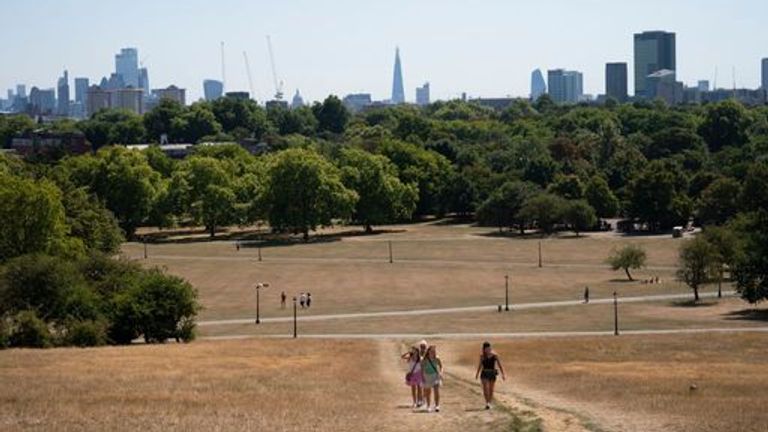Deaths linked to extreme heat on hottest days soar
Between 2018 and 2022, London had the highest mortality risk from hot weather of 29C (84F) or more, according to the latest data from the Office for National Statistics. The figures overall show a dramatic increase on the previous year.
Friday 22 September 2023 19:20, UK
The number of temperature related deaths on hot days has more than doubled from 1990 to 2022, new figures reveal.
On a three-year average in 2022, there were 2,866 deaths on the hottest days - compared to 1,417 in 1990 - a 102% increase, according to the Office for National Statistics (ONS).
There were 4,507 temperature-related deaths on the hottest days of 2022 specifically, which is the highest on record.
This was a dramatic increase on the previous year - with 79.7 heat-related deaths per one million people compared to just 24.9 in 2021.
Despite last year's steep rise, the overall increase in deaths from heat since 1988 has almost remained static so far, when population growth is taken into consideration.
The average annual number of heat deaths per million people between 1988 and 2005 was almost the same as for 2006 to 2023 - 28.8 and 28.9 - after adjusting for population size.
Last summer saw a prolonged heatwave, when parts of England endured a record-breaking 40°C.
A study found that 61,000 people died as a result of extreme heat in Europe between 20 May and 4 September 2022.
Italy had the highest number of heat-related deaths, with 18,010, followed by Spain, with 11,324, and Germany, with 8,173.
The research by Spanish and French scientists put the UK figure at 3,469.
By contrast, the number of deaths from the cold in 2022 was the second lowest on record at 1,214 - compared to 20,163 in 2010.
Although deaths linked to cold weather outnumbered those associated with extreme heat, the ONS analysis shows an increase in heat-related deaths in recent years.
But with rising temperatures resulting in fewer cold-related deaths, there has been an overall fall in temperature-related deaths in general, the figures show.
Between 2018 and 2022, London had the highest mortality risk from hot weather of 29C (84F) or more.
Being in the North East and North West of England carried the lowest risk of dying from hot weather.
The South East had the highest risk of death from cold temperatures - below 8C (46F) - over the same period, but all regions in England saw an increase in deaths from cold temperatures.
Both very hot and very cold conditions carried a high mortality risk in England and Wales, with conditions either below -5C (23F) or above 25C (77F) the most likely to result in deaths.
In England, people were least likely to die as a result of the temperature when it was between 9C (48F) and 22C (72F).
In Wales, the optimal range for low mortality risk was between 8C (46F) and 20C (68F).
Be the first to get Breaking News
Install the Sky News app for free


Extreme heat 'one of biggest public health challenges'
Commenting on the ONS report, the head of the World Health Organisation's (WHO) Climate Change and Health Unit, Dr Diarmid Campbell-Lendrum, said it was "extremely concerning".
He described heat-related deaths as "one of the biggest public health challenges we face as populations get older".
"We have more of the world's population living in cities which tend to be hotter than rural areas, and then we have the climate crisis imposed on top of that, so it's one of the things we're particularly concerned about," he told Sky News.
"If you increase the average temperature just by a degree, it has a disproportionate effect on the extremes.
"Even the modest change in average conditions leads to extreme heat days going up by a multiple of five or 10 or 20 times.
"Now you combine that with a population which is increasingly old, increasingly suffering from pre-existing conditions, increasingly living in cities from around the world and you're talking about multiplying effects."
Read more from Sky News:
Pacific island's plea for ocean sponsors
Before and after pictures from Hawaii wildfires
Which Tory green policies have been scrapped?
He added that poor quality housing across the UK is adding to the problem and disproportionately affecting the more disadvantaged people who live in it.
"What we need is political leaders around the world that have the long-term vision to make the case for the investment, which we know will save money, we know will bring more jobs, we know it will save lives, and it will also solve the climate crisis," he added.
These findings are from a report published by the ONS in partnership with the London School of Hygiene and Tropical Medicine and the Wellcome Trust. They are experimental statistics - the methods are under development, which means estimates may change.

